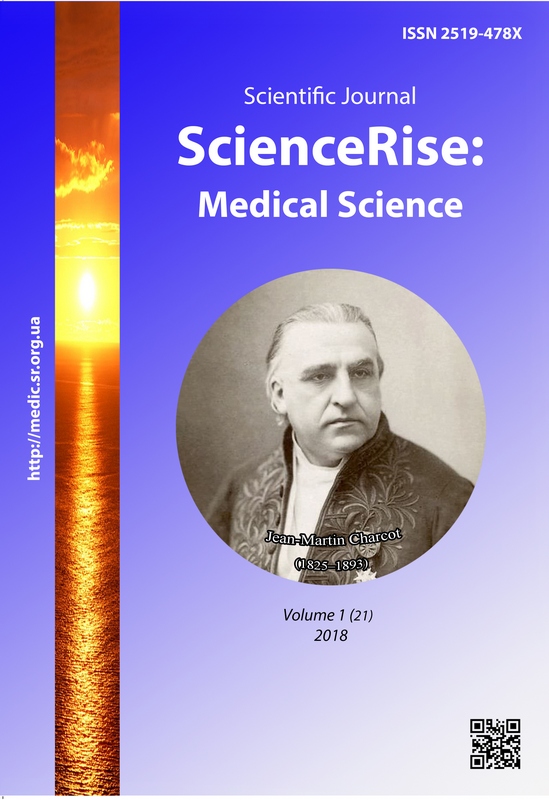Perioperative pain management during laparoscopic cholecystectomy: randomized controlled study
DOI:
https://doi.org/10.15587/2519-4798.2018.122135Keywords:
postoperative pain, laparoscopic cholecystectomy, dexmedetomidine, lidocaine, ketamine, randomized controlled trialAbstract
Aim. Aim of this article was to review current literature regarding perioperative pain management for laparoscopic cholecystectomy.
Methods. The single-center, controlled study was carried out at the department of surgery, anesthesiology and intensive care, Postgraduate Institute of Bogomolets National Medical University. Eligible participants were assigned to intervention groups (Group D; n=30; Group K, n=30; Group L, n=30) or control (Group C; n=30). Group D received dexmedetomidine infusion 0,5 mcg/kg/h from induction in anesthesia to extubation, group L received lidocaine bolus 1mg/kg and infusion 2mcg/kg/h, group K received ketamine bolus 0,5mg/kg and infusion 0,25 mg/kg/h, group C (control) received normal saline infusion.
Results. Dexmedetomidine, lidocaine and ketamine infusion was associated with lower incidence of severe postoperative pain, morphine consumption and significantly higher time to first rescue analgesia. Also patients in group D, L, K had lower intraoperative fentanyl and sevoflurane consumption.
Conclusions. Postoperative pain management after LCE remains one of the most significant challenges. Intraoperative dexmedetomidine, ketamine and lidocaine infusion may be effective and safe to improve analgesia during LCE. Hovewer further controlled randomised studies are requeired for accurate conclusions
References
- Bisgaard, T. (2006). Analgesic Treatment after Laparoscopic Cholecystectomy: A Critical Assessment of the Evidence. Anesthesiology, 104 (4), 835–846. doi: 10.1097/00000542-200604000-00030
- Sarakatsianou, Ch., Georgopoulou, S., Tzovaras, G. (2016). Acute pain management in laparoscopic cholecystectomy: Is there a role for pregabalin? A review. The Greek E-Journal of Perioperative Medicine, 14, 15–24.
- Byshovets, S. M. (2013). Trykomponentna mistseva anesteziia dlia zneboliuvannia laparoskopichnykh vtruchan. Ukrainskyi medychnyi chasopys, 4 (96), 147–150.
- Weibel, S., Jokinen, J., Pace, N. L., Schnabel, A., Hollmann, M. W., Hahnenkamp, K. et. al. (2016).Efficacy and safety of intravenous lidocaine for postoperative analgesia and recovery after surgery: a systematic review with trialsequential analysis. British Journal of Anaesthesia, 116 (6), 770–783. doi: 10.1093/bja/aew101
- Dunn, L. K., Durieux, M. E. (2017). Perioperative Use of Intravenous Lidocaine. Anesthesiology, 126 (4), 729–737. doi: 10.1097/aln.0000000000001527
- Kirillova, I., Teliban, A., Gorodetskaya, N., Grossmann, L., Bartsch, F., Rausch, V. H. et. al. (2011). Effect of local and intravenous lidocaine on ongoing activity in injured afferent nerve fibers. Pain, 152 (7), 1562–1571. doi: 10.1016/j.pain.2011.02.046
- Ghodki, P., Sardesai, S., Thombre, S., Harnagle, K. (2012). Dexmedetomidine as an anesthetic adjuvant in laparoscopic surgery: An observational study using entropy monitoring. Journal of Anaesthesiology Clinical Pharmacology, 28 (3), 334–338. doi: 10.4103/0970-9185.98329
- Manne, G. R., Upadhyay, M. R., Swadia, V. (2014). Effects of low dose dexmedetomidine infusion on haemodynamic stress response, sedation and post-operative analgesia requirement in patients undergoing laparoscopic cholecystectomy. Indian Journal of Anaesthesia, 58 (6), 726–731. doi: 10.4103/0019-5049.147164
- Himmelseher, S., Durieux, M. E. (2005). Ketamine for Perioperative Pain Management. Anesthesiology, 102 (1), 211–220. doi: 10.1097/00000542-200501000-00030
- Singh Bajwa, S., Sharma, R., Gupta, R., Choudhary, R. (2017). Postoperative analgesia with intravenous paracetamol and dexmedetomidine in laparoscopic cholecystectomy surgeries: A prospective randomized comparative study. International Journal of Applied and Basic Medical Research, 7 (4), 218–222. doi: 10.4103/ijabmr.ijabmr_25_17
Downloads
Published
How to Cite
Issue
Section
License
Copyright (c) 2018 Volodymyr Babych

This work is licensed under a Creative Commons Attribution 4.0 International License.
Our journal abides by the Creative Commons CC BY copyright rights and permissions for open access journals.
Authors, who are published in this journal, agree to the following conditions:
1. The authors reserve the right to authorship of the work and pass the first publication right of this work to the journal under the terms of a Creative Commons CC BY, which allows others to freely distribute the published research with the obligatory reference to the authors of the original work and the first publication of the work in this journal.
2. The authors have the right to conclude separate supplement agreements that relate to non-exclusive work distribution in the form in which it has been published by the journal (for example, to upload the work to the online storage of the journal or publish it as part of a monograph), provided that the reference to the first publication of the work in this journal is included.









